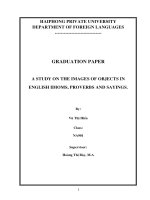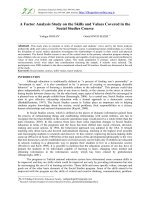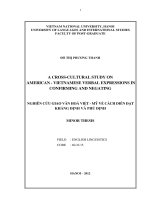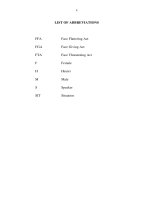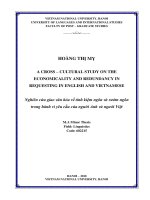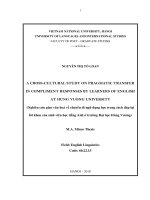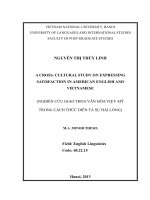A cross – cultural study on the economicality and redundancy in requesting in english and vietnamese
Bạn đang xem bản rút gọn của tài liệu. Xem và tải ngay bản đầy đủ của tài liệu tại đây (1.75 MB, 9 trang )
A cross – cultural study on the economicality
and redundancy in requesting in english and
vietnamese
Hoàng Thi Mỵ
Trường Đại học Ngoại Ngữ
Luận văn ThS. Chuyên ngành: Linguistics; Mã Số: 60 22 15
Người hướng dẫn: Do Thi Mai Thanh, M.A
Năm bảo vệ: 2010
Abstract: When people from different linguistic and cultural background come into contact,
misunderstandings are inevitable, as a result of clashing rules of interaction and language habits.
This thesis was carried out to provide a cross –cultural comparison of speech behavior in English
and Vietnamese in the act of requesting, with the focus on the popularity of redundancy and
economicality in requesting; and the link between the addresser’s/ addressee’s gender and
relative age and the use of lexico modal makers seen as redundancy – creating factors. A
questionnaire was designed consisting of 3 situations to collect data from 100 students (50 from
Vietnam and 50 from English –speaking countries) with the evenly distributed number of males
and females. The collected data were categorized into 4 groups of communicative partner: same
sex but younger, same sex but older, opposite sex but younger and opposite sex but older; and
analyzed according to 14 types of lexico modal markers suggested by N.Quang and Blum-kulka
The findings of the study provide that addressee’s gender and relative status exert considerable
influence on the ways people make request. Particularly, in Vietnamese what type of lexico
modal markers can be employed for each communicative partner depends largely on the level of
politeness of such markers, whereas in English, there seems to be no clear-cut distinction. The
results also revealed that in both cultures, no significant difference in language behavior can be
found in both male and female. The findings of the study also enable the researcher to advance
some suggestions for avoidance of communication breakdown and potential culture shock and
some implications for ELT.
Keywords: Giao văn hóa; Ngôn từ; Tiếng Anh.
Content:
6
TABLE OF CONTENTS
Declaration i
Acknowledgements ii
Abstract iii
List of abbreviations iv
List of tables v
PART A: INTRODUCTION 1
1. Rationale and the statement of the problem 1
2. Aims of the study 3
3. Significance of the study 3
4. Scope of the study 4
5. Method of the study 4
PART B: DEVELOPMENT 5
CHAPTER 1: LITERATURE REVIEW 5
1.1. Speech acts and classification of speech acts 5
1.2. Requesting as a speech act 7
1.3. Redundancy and classification of redundancy 9
1.3.1. Redundancy 9
1.3.2. Classification of redundancy 10
1.3.2.1. Modality redundancy 10
1.3.2.2. Habitual redundancy 11
1.3.2.3. Insufficient redundancy 11
1.4. Economicality and classification of economicality 11
1.4.1. Economicality 11
1.4.2. Classification of economicality 11
1.4.2.1. Modality economicality 11
1.4.2.2. Habitual economicaltiy 12
1.4.2.3. Insufficient economicality 12
1.5. Lexico modal markers 12
7
1.6. Previous studies on lexico modal markers, addresser’s/addressee’s gender and relative
age when making requests. 15
CHAPTER 2: METHODOLOGY 18
2.1. Research design 18
2.2. Participants 18
2.3. Data collection instrument 19
2.4. Data collection procedures. 20
2.5. Data analysis methods and procedures 20
CHAPTER 3: FINDINGS AND DISCUSSION 22
3.1. The popularity of economicality and redundancy in requesting 22
3.2. The link between the addresser’s/ addressee’s gender and relative age and the use of
lexico modal makers seen as redundancy – creating factors 24
3.2.1. The use of lexico modal markers for communicative partner of same sex and
younger 25
3.2.2. The use of lexico modal markers for communicative partner of same sex and older. 29
3.2.3. The use of lexico modal markers for communicative partner of opposite sex and
younger. 33
3.2.4. The use of lexico modal markers for communicative partner of opposite sex and
older .36
PART C: CONCLUSION 40
1. Conclusions 40
2. Pedagogical implications 41
3. Suggestions for further study 42
REFERENCES 43
APPENDIX I
8
PART A: INTRODUCTION
1. Rationale and the statement of the problem
The emergence of English as a global language has presented a solution to language barrier
and brought people closer together and its contribution towards such fields as economy,
culture, education, science, technology etc, is undeniable. Mastering a good competence of
English not only brings benefits in business, cultural exchanges, education and
development to nation-states but can benefit individuals as they will have greater career
opportunities. In the contemporary context of international integration and economic
globalization, the role of using English in communication has never been so important to
people worldwide, including the Vietnamese. The open door policy has brought the
contrasting effects (both threats and opportunities) to national economic climate with the
strong performance of foreign companies and the significant changes in employment
market, which is accompanied by the increasing demand of skilled and English –fluent
speaking workforce. In order to meet such requirements, English teaching programs in
Vietnam have shifted from a focus on the linguistic competence to the communicative
competence.
According to Hymes (1976), the communicative competence includes not only knowledge
of the linguistic forms of a language but the knowledge of when, how and to whom it is
appropriate to use these forms as well. In another word, when communicating, people do
not only attempt to produce grammatically correct sentences, but also try to apply them in
the right combination of context. What is more, language is also intimately bound up with
culture. There is mounting evidence that learning a language produces physiological
changes in our brain, which could affect our thoughts and perceptions. The patterns and
connections we make among various concepts may be structured by the linguistic habits of
our community. It is observed that many people from different cultures, when
communicating using one common language often impose their culture on that language.
As a result, it may be difficult for the communication process, including verbal and non-
verbal communication with its influential socio-cultural factors. Thus, communicative
competence involves the understanding of culture, social knowledge and other skills of
interaction. According to J.Richard et al (1985, p.49), “when someone wishes to
communicate with others, they must recognize the social setting, their relationship to the
9
other person(s), and the types of language that can be used for a particular occasion. They
must also interpret written or spoken sentences within the total context in which they are
used”.
However, in Vietnam, there is a fact that English though has been taught for many years,
little attention of learners has been paid to the rules of speaking and oral practice, and even
less attention to culture-specific verbal and non-verbal behavior. Vietnamese learners tend
to translate whatever ideas they want to express into the target language with and effort of
making their utterances grammatically correct without awareness of cross-cultural
differences. Consequently, failure in applying what they have learnt to actual
communication is inevitable despite their fairly good knowledge of grammar and a
considerable amount of vocabulary. An invisible communication barrier may occur and
culture shock may happen due to their insufficient knowledge of social norms and values,
roles and relations between individuals. There have been many cases where the
inappropriateness of utterances has produced unwanted communication breakdown in
socio-cultural interaction.
With the aim to achieve successful communication in the real world, numerous cross-
cultural studies have been carried out so far to help the Vietnamese speakers of English
avoid confusion when expressing themselves, especially in situations which require
sensitive speech acts such as requesting, apologizing, etc. Requesting – one of the most
sensitive illocutionary acts in English and Vietnamese – has been the topic of so many
researches whose major findings mainly point out the basic differences between
Vietnamese and English when using politeness, directness or indirectness strategies in
requesting. However, little is known about request segments which can be seen as
redundancy and whether the redundant language elements constituting a request such as
“just a tiny bit” in English or “một chút xíu” in Vietnamese should be considered as a
politeness strategy or just a language marker by people from different cultures. More
importantly, how these redundant elements or terminologically known as “ lexico modal
marker’ or “modality markers” are linked to the addresser’s/ addressee’s gender and
relative age in both cultures requires a further clarification. All the reasons above motivate
me to conduct a research on economicality and redundancy in requesting in English and
Vietnamese culture with the hope of discovering answers to the uncertainty and promoting
awareness of cross-cultural differences in English and Vietnamese culture.
10
2. Aims of the study
The aims of the study are;
- To explore the popularity of redundant and economical factors in making requests
in the specific situations, under certain variables such as age, the addresser’s/
addressee’s gender and relative age in English and Vietnamese
- To compare and contrast the range of lexico modal markers or modality markers
constituting the redundancy and economicality in requesting in order to clarify the
similarities and differences in the way Vietnamese and English – speaking people
request in their own language and culture.
- To contribute to promoting cross-cultural awareness among foreign language
teachers and learners was well as other potential interactants in cross-cultural
communication.
In brief, this paper aimed to address three following
research questions:
1. Is economicality or redundancy preferred by the Vietnamese and English people
when making requests?
2. Is the use of these economicality/redundancy factors linked to the addresser’s/
addressee’s gender and relative age?
3. Significance of the study
Although the study was carried out on a small scale, within a minor thesis of 40 pages, it is
expected to be a contributing factor to rising awareness of both Vietnamese teachers and
learners of English on the cultural similarities and differences between the two languages
when using redundancy and economicality factors in requesting. More importantly, from
the major findings of the study, Vietnamese speakers of English may get to know to use
appropriately modality markers in requesting in different situations when communicating
with English -speaking foreigners. In addition, the study is expected to be useful and
accessible to all teachers, learners and researchers as a material and reference of cross-
cultural communication.
11
4. Scope of the study
This study follows the speech act approach. It focuses mainly on verbal communication
and analysis of the data collected from the survey questionnaire. The questionnaire
designed to elicit the informant’s request forms in the proposed situations.
It is observed that redundancy factors are more popular to people when making request
than economicality ones. The study especially centers on the similarities and differences
between English and Vietnamese students in using modality markers as redundancy factors
to make requests to people of different ages and genders in some given situations. The
Vietnamese Northern dialect and the English language spoken in the United State, Great
Britain and Australia (whose cultures are referred to as Anglicist cultures) are chosen for
contrastive analysis. The data are collected by conducting survey questionnaires, which
enables the researcher to get information from a large population in a short period of time.
Recorded and videotaped face –to-face conversations are impossible due to limitations of
time, geographical distance and financial difficulties.
5. Method of the study
The research method used in the study is the survey research – a kind of quantitative one.
All the considerations, remarks, comments and assumptions given in the thesis are based
largely on the analysis of statistic data with due reference to publication.
The practical approaches are
- Studying relevant publications
- Conducting survey questionnaires
- Analyzing the collected data
- Resorting to personal observations and experience
- Consulting the supervisor
- Discussing with Vietnamese and foreign colleagues
50
REFERENCES
1. Austin, J.L, 1962. How to do things with words. Oxford University Press.
2. Blum-Kulka, S.and Olshtain, E, 1984. Request and Apologies: a cross –cultural study of
Speech Acts Realization Patterns (CCSSARP) – Applied Linguistics, vol 5 – No 3.
3. Blum-Kulka, S, 1982. Learning to say what you mean in a second language – A study of
the Speech Act Performance of Learners of Hebrew as a Second Language – Applied
Linguistics 3: 29 -59.
4. Blum-Kulka, S; Julian, House and Kasper, G -1989. Cross-cultural Pragmatics:
Requests and Apologies. Norwood, New Jersey, Ablex Publishing Corporation.
5. Blum-Kulka, S, 1985. Modifiers as Indicating Devices: The case of Requests.
Theoretical Linguistics 12: 213-29
6. Blum-Kulka, S, 1987. Indirectness and Politeness in Requests: Same or different?
Journal of pragmatics II, North Holland
7. Brown, G. And Yule, G, 1989. Discourse Analysis. Cambridge University Press.
8. Brown, P. and Levinson, S. 1987. Politeness: Some universals in Language Usage.
Cambridge University Press
9. Hymes, D, 1966. Language in Culture and Society. Harper International Edition
10. Cameron, D, 1998. Is there any ketchup, Vera? : Gender, Power and Pragmatics.
Discourse and Society, 9/4
11. Cohen, A, 1996. Investigating the Production of Speech Act sets. Speech acts across
Cultures: Challenges to Communication in a second Language. Berlin, New York.
12. Eckert, P. and McConnell –Ginet, S, 1999. New Generalisations and Explanations in
Language and Gender Research. Language in Society, 28/2
51
13. Holmes, Janet, 1992. Women’s talk in public contexts. Discourse and Society 3.2: 131-
150.
14. Holmes, Janet, 1995. Women, Men and Politeness. London: Longman
15. Hymes, D, 1976. Models of the Interaction of Language and Social Setting. Journal
social issues: Problem of Bilingualism.
16. Leech, G, 1983. Principles of Pragmatics. London, New York, Longman.
17. Mills, S, 1997. Feminist Stylistics. London, Routledge.
18. Searle, J.R, 1969. Speech Acts. Cambridge University Press.
19. Tam, H.C, 1998. Requests by Australia Native Speakers of English and Vietnamese
learners of English. M.A. Thesis. La Trobe University.
20. Thanh, D.T.M, 2000. Some English –Vietnamese cross – cultural differences in
Requesting. M.A. Thesis. VNU – CFL. Hanoi
21. Yen, N.T.Q, 2007. Gender and politeness strategies in requesting. M.A. Thesis. VNU
– CFL. Hanoi
22. Nguyen Quang, 1998. Vietnamese – American Cross – Cultural Differences in
Extending and Encountering Compliments – as seen from Communicative activities. Ph.D.
Thesis.
23. Nguyen Quang, 1998, Intercultural Communication, VNU, CFL.
24. Nguyễn Quang – Trực tiếp và gián tiếp trong dụng học giao thoa văn hóa Việt – Mỹ -
Tập san ngoại ngữ số 4/96.
25. Nguyễn Quang – Sắc thái quyền lực trong giao tiếp ngôn ngữ - Tập san Ngoại ngữ số
1/2001.
26. Nguyễn Quang – Một số phạm trù giao thoa văn hóa Việt – Mỹ trong hoạt động giao
tiếp – Tập san ngoại ngữ số 4/96.
27. Nguyễn Thị Thanh Bình, 1996. Sự lễ phép trong giao tiếp ngôn ngữ gia đình ở lời cầu
khiến trong Ứng xử ngôn ngữ trong giao tiếp gia đình người Việt, Nguyễn Văn Khang chủ
biên, Nhà xuất bản văn hóa thông tin, Hà Nội.

